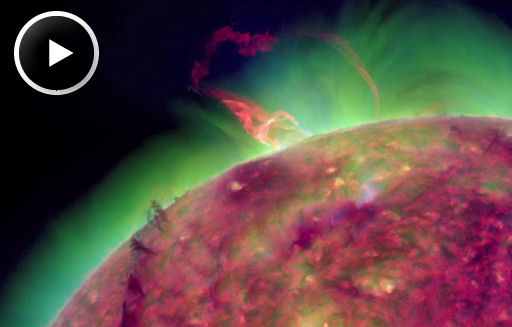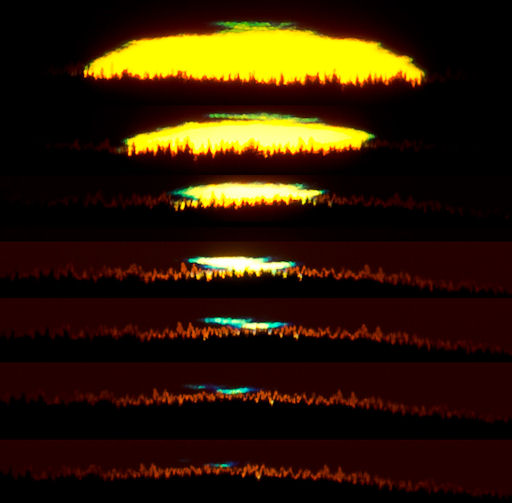CURIOSITY'S SEVEN MINUTES OF TERROR: In a new must-see video from NASA, Mars Science Lab team members preview the "seven minutes of terror" in store for Curiosity as the rover prepres to land on the Red Planet. Highly recommended.
PHOTOGENIC, NOT GEOEFFECTIVE: A long filament of magnetism snaking over the sun's northwestern limb erupted this morning, hurling much of itself into space. NASA's Solar Dynamics Observatory recorded the blast:
A bright CME billowed away from the blast site. Because of the explosion's location on the NW edge of the solar disk, the cloud will not hit Earth. This event was photogenic but not geoeffective. Solar flare alerts: text, voice.
Realtime Space Weather Photo Gallery
GREEN FLASH, BLUE FLASH: Green flashes at sunset are rare. Indeed, they were once thought mythological. Blue flashes are rarer still. On June 21st Göran Strand of Frösön, Sweden, saw them both in a single sunset:
"Tonight the weather was incredibly clear and fine, so I went out to photograph the sunset--and this was the result," says Strand. "The time interval between the first and last frames is 1 minute and 14 seconds."
Green flashes are formed when the prismatic action of the atmosphere splits the setting sun into basic R-G-B colors. Temperature inversions create a mirage, magnifying the green into an eye-catching flash.
Blues flashes are formed in the same way, but they are generally harder to see than green flashes, because blue flashes blend into the surrounding blue sky. When the air is exceptionally clear, however, the blue flash emerges.
For more rare sights occuring right now, browse the new Realtime Space Weather Photo Gallery.

Solar wind
speed: 411.0 km/sec
density: 3.1 protons/cm3
explanation | more data
Updated: Today at 1847 UT
X-ray Solar Flares
6-hr max: B2 1203 UT Jun23
24-hr: C2 0752 UT Jun23
explanation | more data
Updated: Today at: 1800 UT
![]()
Daily Sun: 23 Jun 12
A small sunspot is emerging at the circled location. Otherwise, the Earth-facing side of the sun is blank. Credit: SDO/HMI
![]()
Sunspot number: 13
What is the sunspot number?
Updated 21 Jun 2012
Spotless Days
Current Stretch: 0 days
2012 total: 0 days (0%)
2011 total: 2 days (<1%)
2010 total: 51 days (14%)
2009 total: 260 days (71%)
Since 2004: 821 days
Typical Solar Min: 486 days
Updated 21 Jun 2012
The Radio Sun
10.7 cm flux: 104 sfu
explanation | more data
Updated 21 Jun 2012
![]()
Current Auroral Oval:
Switch to: Europe, USA, New Zealand, Antarctica
Credit: NOAA/POES
![]()
Planetary K-index
Now: Kp= 2 quiet
24-hr max: Kp= 2 quiet
explanation | more data
Interplanetary Mag. Field
Btotal: 4.0 nT
Bz: 0.5 nT south
explanation | more data
Updated: Today at 1847 UT
![]()
Coronal Holes: 22 Jun 12
Solar wind flowing from this northern coronal hole could brush against Earth's magnetic field on June 28-29. Credit: SDO/AIA.





